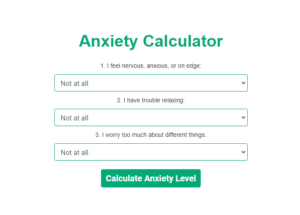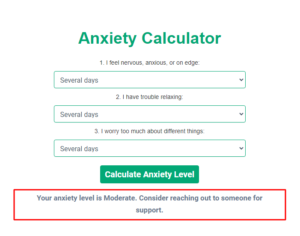Anxiety Calculator
Anxiety is a common mental health challenge that affects millions of people worldwide. Whether it’s due to stress, worry, or overwhelming situations, anxiety can impact daily life and overall well-being. However, by tracking and monitoring anxiety levels, individuals can gain valuable insights into their emotional state, identify triggers, and develop strategies for better mental health management.
In this blog post, we introduce the Anxiety Calculator—a tool designed to help individuals track their anxiety levels with ease. By answering a few simple questions, users can assess their anxiety and gain insights into how to manage it effectively. Let’s dive deeper into how the Anxiety Calculator works and the benefits it offers.
What Is the Anxiety Calculator?
The Anxiety Calculator is a user-friendly online tool that helps individuals evaluate their anxiety levels. It allows users to assess how anxious they feel based on their answers to a set of questions related to their emotional and physical states. The tool uses a scoring system to provide a numerical representation of one’s anxiety level, offering a starting point for understanding and managing anxiety.
The Anxiety Calculator is designed to be an easy-to-use tool that can be accessed via a website. It provides valuable insights into anxiety levels and gives users a sense of control over their mental health. By using this tool, individuals can better understand their anxiety, identify patterns, and find ways to cope with their emotions.
Example of How the Anxiety Calculator Works:
The Anxiety Calculator asks a few simple questions such as:
- How often do you feel anxious or stressed?
- How physically affected are you by anxiety (e.g., heart racing, sweating)?
- Do you experience frequent worry or fear?
Based on the answers, the calculator generates a score, ranging from low anxiety to high anxiety, helping users understand their current emotional state.
How Does the Anxiety Calculator Work?
Using the Anxiety Calculator is simple and straightforward. Here’s a step-by-step guide on how the tool works:
Access the Tool: The Anxiety Calculator is available directly on the website. It’s integrated into a post using a shortcode widget, making it easy to access from any device, whether on a desktop, laptop, or mobile device.
Enter Your Data: Users will be prompted to answer a series of questions that cover various aspects of their anxiety. These questions focus on how frequently users experience feelings of worry, physical symptoms related to anxiety, and the emotional impact they feel in their daily lives.

Get Results: After submitting their answers, users will receive a score that reflects their level of anxiety. This score can range from mild to severe, helping users understand the intensity of their anxiety.

Review the Results: Once the results are displayed, users can interpret the information and use it to guide decisions regarding their mental health. The Anxiety Calculator may also provide some recommendations for coping strategies or suggest seeking professional help if needed.
Benefits of Using the Anxiety Calculator
Tracking anxiety is an important step in managing mental health, and the Anxiety Calculator offers several benefits to its users. Here are some of the key advantages of using the tool:
Understanding Anxiety Triggers: By tracking anxiety levels over time, users can identify specific triggers—whether they’re related to work, relationships, or personal concerns—that contribute to heightened anxiety. This understanding can empower users to take action and make positive changes in their lives.
Identifying Patterns in Anxiety Levels: Regular use of the Anxiety Calculator can help users identify patterns in their anxiety. For example, they may notice that their anxiety levels rise during certain situations or times of day. Recognizing these patterns can lead to more effective coping strategies.
Getting Recommendations for Coping Strategies: Based on the results, the Anxiety Calculator may suggest helpful coping mechanisms, such as mindfulness techniques, breathing exercises, or lifestyle changes, to help reduce anxiety and improve mental health.
Empowering Individuals to Take Action: By regularly tracking their anxiety levels, users can become more proactive about their mental health. They may recognize when their anxiety is becoming overwhelming and take steps to address it before it escalates.
Encouraging Professional Help: If the results from the Anxiety Calculator indicate high anxiety levels, the tool may suggest seeking professional help from a therapist or counselor. This can provide users with additional resources and support to manage their anxiety effectively.
Why Is It Important to Track Anxiety?
Monitoring mental health, especially anxiety, is crucial for overall well-being. Anxiety is not just a feeling of unease; it can have physical effects on the body, such as increased heart rate, shallow breathing, and muscle tension. Over time, untreated anxiety can lead to more severe health problems, including depression, sleep disorders, and cardiovascular issues.
Tracking anxiety levels using tools like the Anxiety Calculator can provide several important benefits:
Better Awareness: When users track their anxiety, they gain a better understanding of their mental health. Awareness is the first step toward positive change, as individuals can recognize when their anxiety is becoming problematic and seek help before it worsens.
Early Intervention: By tracking anxiety levels over time, users can identify when their anxiety is increasing and take steps to address it before it escalates into more serious health issues. Early intervention is key to managing anxiety effectively.
Holistic Approach: Regular monitoring of anxiety can lead to a more holistic approach to mental health. It encourages users to consider how physical, emotional, and environmental factors all contribute to their anxiety, leading to better overall management.
Improved Coping Strategies: By tracking anxiety over time, users can see which coping strategies work best for them. This allows them to refine their approach and develop more effective techniques to manage anxiety.
How to Interpret the Results from the Anxiety Calculator
Once the Anxiety Calculator generates results, users may be unsure about what their scores mean and how to interpret them. Here’s a breakdown of how to understand the results:
Understanding Anxiety Scores:
- Low Anxiety: A score in this range typically indicates that anxiety is not a significant issue. Users may still feel some stress or worry, but it’s not interfering with daily life.
- Moderate Anxiety: This score suggests that anxiety is present and may be affecting daily activities, but it’s still manageable. Users with moderate anxiety may benefit from stress-reduction techniques or talking to a mental health professional.
- High Anxiety: A high score indicates that anxiety is significantly impacting a person’s life. This may include frequent physical symptoms, intrusive thoughts, or difficulty functioning in social or professional settings. Users in this category may want to seek professional support.
Next Steps Based on Results:
- For Low Anxiety: Continue tracking anxiety levels periodically and implement relaxation techniques to maintain mental balance.
- For Moderate Anxiety: Consider integrating stress management strategies, such as regular exercise, mindfulness, or seeking professional advice if necessary.
- For High Anxiety: Seek immediate support from a healthcare provider or therapist to develop a personalized plan for managing anxiety.
Who Can Benefit from the Anxiety Calculator?
The Anxiety Calculator is useful for anyone who experiences anxiety, regardless of age or lifestyle. However, certain groups of people may benefit particularly from using the tool:
Young Adults: College students or young professionals dealing with the pressures of academics, work, or relationships can benefit from tracking their anxiety levels.
Parents: Individuals balancing family responsibilities, work, and personal life may experience high levels of anxiety. The Anxiety Calculator can help them manage their stress.
Professionals: People in high-stress professions, such as healthcare workers, lawyers, and executives, may find the tool useful for managing work-related anxiety.
People with Generalized Anxiety Disorder (GAD): Those diagnosed with GAD or other anxiety disorders can use the Anxiety Calculator to monitor their symptoms and take proactive steps in managing their condition.
Case Studies or Testimonials
Here are a few examples of how the Anxiety Calculator has helped real users:
John, 34: “I’ve been dealing with work-related stress for years. After using the Anxiety Calculator for a few weeks, I noticed a pattern of high anxiety on Mondays. This gave me the insight to prioritize self-care over the weekend and manage my anxiety better during the workweek.”
Sarah, 28: “As a student, I struggled with anxiety, especially during exams. The Anxiety Calculator helped me track how stress affected me, and I now use it to monitor my levels before big tests. It’s a great way to stay on top of my mental health.”
Conclusion
In summary, the Anxiety Calculator is an essential tool for anyone looking to track and manage their anxiety. By regularly assessing anxiety levels, users can gain a deeper understanding of their emotional state, identify triggers, and develop strategies for better mental health. Whether you experience mild anxiety or struggle with more severe symptoms, the Anxiety Calculator can provide valuable insights into how to improve your well-being.
We encourage you to try out the Anxiety Calculator on our website today. It’s a simple, effective way to monitor your anxiety levels and take the first step toward better mental health.
Start tracking your anxiety now and empower yourself to live a more balanced life.
